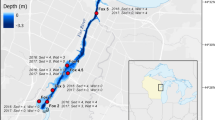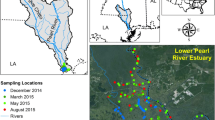Abstract
Dissolved organic carbon (DOC) concentration and dissolved organic matter (DOM) optical properties were analyzed along two estuarine river transects during the wet and dry seasons to better understand DOM dynamics and quantify mangrove inputs. A tidal study was performed to assess the impacts of tidal pumping on DOM transport. DOM in the estuaries showed non-conservative mixing indicative of mangrove-derived inputs. Similarly, fluorescence data suggest that some terrestrial humic-like components showed non-conservative behavior. An Everglades freshwater-derived fluorescent component, which is associated with soil inputs from the Northern Everglades, behaved conservatively. During the dry season, a protein-like component behaved conservatively until the mid-salinity range when non-conservative behavior due to degradation and/or loss was observed. The tidal study data suggests mangrove porewater inputs to the rivers following low tide. The differences in quantity of DOM exported by the Shark and Harney Rivers imply that geomorphology and tidal hydrology may be a dominant factor controlling the amount of DOM exported from the mangrove ecotone, where up to 21 % of the DOC is mangrove-derived. Additionally, nutrient concentrations and other temporal factors may control DOM export from the mangroves, particularly for the microbially derived fluorescent components, contributing to the seasonal differences. The wet and dry season fluxes of mangrove DOM from the Shark River is estimated as 0.27 × 109 mg C d−1 and 0.075 × 109 mg C d−1, respectively, and the Harney River is estimated as 1.9 × 109 mg C d−1 and 0.20 × 109 mg C d−1.






Similar content being viewed by others
References
Adame, M.F., and C.E. Lovelock. 2011. Carbon and nutrient exchange of mangrove forests with the coastal ocean. Hydrobiologia 663: 23–50.
Adame, M.F., R. Reef, J.A. Herrera-Silveira, and C.E. Lovelock. 2012. Sensitivity of dissolved organic carbon exchange and sediment bacteria to water quality in mangrove forests. Hydrobiologia 691: 239–253.
Amon, R.M.W., and R. Benner. 1994. Rapid-cycling of migh-molecular-weight dissolved organic-matter in the ocean. Nature 369: 549–552.
Bergamaschi, B.A., D.P. Krabbenhoft, G.R. Aiken, E. Patino, D.G. Rumbold, and W.H. Orem. 2012. Tidally driven export of dissolved organic carbon, total mercury, and methyl mercury from a mangrove-dominated estuary. Environmental Science and Technology 46: 1371–1378.
Bertilsson, S., and L.J. Tranvik. 1998. Photochemically produced carboxylic acids as substrates for freshwater bacterioplankton. Limnology and Oceanography 43: 885–895.
Bouillon, S., A.V. Borges, E. Castaneda-Moya, K. Diele, T. Dittmar, N.C. Duke, E. Kristensen, S.Y. Lee, C. Marchand, J.J. Middelburg, V.H. Rivera-Monroy, T.J. Smith, and R.R. Twilley. 2008. Mangrove production and carbon sinks: a revision of global budget estimates. Global Biogeochemical Cycles 22, GB2013. doi:10.1029/2007GB003052.
Bouillon, S., J.J. Middelburg, F. Dehairs, A.V. Borges, G. Abril, M.R. Flindt, S. Ulomi, and E. Kristensen. 2007. Importance of intertidal sediment processes and porewater exchange on the water column biogeochemistry in a pristine mangrove creek (Ras Dege, Tanzania). Biogeosciences 4: 311–322.
Boyd, T.J., B.P. Barham, G.J. Hall, and C.L. Osburn. 2010. Variation in ultrafiltered and LMW organic matter fluorescence properties under simulated estuarine mixing transects: 1. Mixing alone. Journal of Geophysical Research–Biogeosciences 115: G00F13. doi:10.1029/2009JG000992.
Boyer, J.N., S.K. Dailey, P.J. Gibson, M.T. Rogers, and D. Mir-Gonzalez. 2006. The role of dissolved organic matter bioavailability in promoting phytoplankton blooms in Florida Bay. Hydrobiologia 569: 71–85.
Coronado-Molina, C., H. Alvarez-Guillen, J.W. Day, E. Reyes, B.C. Perez, F. Vera-Herrera, and R. Twilley. 2012. Litterfall dynamics incarboate and deltaic mangrove ecosystems in the Gulf of Mexico. Wetlands Ecology and Management 20: 123–136.
Cawley, K.M., P. Wolski, N. Mladenov, and R. Jaffé. 2012. Dissolved organic matter biogeochemistry along a transect of the Okavango Delta, Botswana. Wetlands 32: 475–486.
Childers, D.L., J.N. Boyer, S.E. Davis, C.J. Madden, D.T. Rudnick, and F.H. Sklar. 2006. Relating precipitation and water management to nutrient concentrations in the oligotrophic “upside-down” estuaries of the Florida Everglades. Limnology and Oceanography 4351: 602–616.
Chen, M., N. Maie, K. Parish, and R. Jaffé. 2013. Spatial and temporal variability of dissolved organic matter quantity and composition in an oilgotrophic subtropical coastal wetland. Biogeochemistry. doi:10.1007/s10533-013-9826-4.
Chen, M.L., R.M. Price, Y. Yamashita, and R. Jaffé. 2010. Comparative study of dissolved organic matter from groundwater and surface water in the Florida coastal Everglades using multi-dimensional spectrofluorometry combined with multivariate statistics. Applied Geochemistry 25: 872–880.
Davis, S.E., D.L. Childers, J.W. Day, D.T. Rudnick, and F.H. Sklar. 2001. Wetland-water column exchanges of carbon, nitrogen, and phosphorus in a southern Everglades dwarf mangrove. Estuaries 24: 610–622.
Del Castillo, C.E., P.G. Coble, J.M. Morell, J.M. Lopez, and J.E. Corredor. 1999. Analysis of the optical properties of the Orinoco River plume by absorption and fluorescence spectroscopy. Marine Chemistry 66: 35–51.
Dittmar, T., R.J. Lara, and G. Kattner. 2001. River or mangrove? Tracing major organic matter sources in tropical Brazilian coastal waters. Marine Chemistry 73: 253–271.
Dittmar, T., N. Hertkorn, G. Kattner, and R.J. Lara. 2006. Mangroves, a major source of dissolved organic carbon to the oceans. Global Biogeochemical Cycles 20, GB1012. doi:10.1029/2005GB002570.
Fellman, J.B., R.G.M. Spencer, P.J. Hernes, R.T. Edwards, D.V. D'Amore, and E. Hood. 2010. The impact of glacier runoff on the biodegradability and biochemical composition of terrigenous dissolved organic matter in near-shore marine ecosystems. Marine Chemistry 121: 12–22.
Gonsior, M., B.M. Peake, W.T. Cooper, D. Podgorski, J. D’Andrilli, and W.J. Cooper. 2009. Photochemically induced changes in dissolved organic matter identified by ultrahigh resolution fourier ion cyclotron resonance mass spectrometry. Environmental Science and Technology 43: 698–703.
Hedges, J.I., R.G. Keil, and R. Benner. 1997. What happens to terrestrial organic matter in the ocean? Organic Geochemistry 27: 195–212.
Hope, D., M.F. Billett, and M.S. Cresser. 1994. A review of the export of carbon in river water—fluxes and processes. Environmental Pollution 84: 301–324.
Ishii, S.K.L., and T.H. Boyer. 2012. Behavior of reoccurring PARAFAC components in fluorescent dissolved organic matter in natural and engineered systems: a critical review. Environmental Science and Technology 46: 2006–2017.
Jaffé, R., J.N. Boyer, X. Lu, N. Maie, C. Yang, N.M. Scully, and S. Mock. 2004. Source characterization of dissolved organic matter in a subtropical mangrove-dominated estuary by fluorescence analysis. Marine Chemistry 84: 195–210.
Khodse, V.B., and N.B. Bhosle. 2011. Bacterial utilization of size-fractionated dissolved organic matter. Aquatic Microbial Ecology 64: 299–309.
Kristensen, E., S. Bouillon, T. Dittmar, and C. Marchand. 2008. Organic carbon dynamics in mangrove ecosystems: a review. Aquatic Botany 89: 201–219.
Lou, T., and H.X. Xie. 2006. Photochemical alteration of the molecular weight of dissolved organic matter. Chemosphere 65: 2333–2342.
Maie, N., R. Jaffé, T. Miyoshi, and D.L. Childers. 2006. Quantitative and qualitative aspects of dissolved organic carbon leached from senescent plants in an oligotrophic wetland. Biogeochemistry 78: 285–314.
Maie, N., O. Pisani, and R. Jaffé. 2008. Mangrove tannins in aquatic ecosystems: their fate and possible influence on dissolved organic carbon and nitrogen cycling. Limnology and Oceanography 53: 160–171.
Maie, N., Y. Yamashita, R.M. Cory, J.N. Boyer, and R. Jaffé. 2012. Application of excitation emission matrix fluorescence monitoring in the assessment of spatial and seasonal drivers of dissolved organic matter composition: sources and physical disturbance controls. Applied Geochemistry 27: 917–929.
McKnight, D.M., E.W. Boyer, P.K. Westerhoff, P.T. Doran, T. Kulbe, and D.T. Andersen. 2001. Spectrofluorometric characterization of dissolved organic matter for indication of precursor organic material and aromaticity. Limnology and Oceanography 46: 38–48.
Ohno, T. 2002. Fluorescence inner-filtering correction for determining the humification index of dissolved organic matter. Environmental Science and Technology 4: 742–746.
Osburn, C.L., L. Retamal, and W.F. Vincent. 2009. Photoreactivity of chromophoric dissolved organic matter transported by the Mackenzie River to the Beaufort Sea. Marine Chemistry 115: 10–20.
Ouyang, Y. 2003. Simulating dynamic load of naturally occurring TOC from watershed into a river. Water Research 37: 823–832.
Pace, M.L., I. Reche, J.J. Cole, A. Fernandez-Barbero, I.P. Mazuecos, and Y.T. Prairie. 2012. pH change induces shifts in the size and light absorption of dissolved organic matter. Biogeochemistry 108: 109–118.
Pisani, O., Y. Yamashita, and R. Jaffe. 2011. Photo-dissolution of flocculent, detrital material in aquatic environments: Contributions to the dissolved organic matter pool. Water Research 45: 3836–3844.
Price, R.M., P.K. Swart, and J.W. Fourqurean. 2006. Coastal groundwater discharge—an additional source of phosphorus for the oligotrophic wetlands of the Everglades. Hydrobiologia 569: 23–36.
Robertson, A., D. Alongi, and K. Boto. 1992. Food chains and carbon fluxes. In Tropical Mangrove Ecosystems, Coastal, and Estuarine Studies Series, ed. A. Robertson and D. Alongi, 293–326. Washington, D.C: American Geophysical Union.
Romigh M. 2005. Organic carbon flux at the mangrove soil-water column interface in the Florida Coastal Everglades. M.S., Texas A & M, Collage Station 45.
Romigh, M.M., S.E. Davis, V.H. Rivera-Monroy, and R.R. Twilley. 2006. Flux of organic carbon in a riverine mangrove wetland in the Florida Coastal Everglades. Hydrobiologia 569: 505–516.
Shank, G.C., R. Lee, A. Vahatalo, R.G. Zepp, and E. Bartels. 2010. Production of chromophoric dissolved organic matter from mangrove leaf litter and floating Sargassum colonies. Marine Chemistry 119: 172–181.
Sierra, M.M.D., O.F.X. Donard, and M. Lamotte. 1997. Spectral identification and behaviour of dissolved organic fluorescent material during estuarine mixing processes. Marine Chemistry 58: 51–58.
Stedmon, C.A., C.L. Osburn, and T. Kragh. 2010. Tracing water mass mixing in the Baltic-North Sea transition zone using the optical properties of coloured dissolved organic matter. Estuarine, Coastal and Shelf Science 87: 156–162.
Sutula, M.A., B.C. Perez, E. Reyes, D.L. Childers, S. Davis, J.W. Day, D. Rudnick, and F. Sklar. 2003. Factors affecting spatial and temporal variability in material exchange between the Southern Everglades wetlands and Florida Bay (USA). Estuarine, Coastal and Shelf Science 57: 757–781.
Tzortziou, M., P.J. Neale, C.L. Osburn, J.P. Megonigal, N. Maie, and R. Jaffé. 2008. Tidal marshes as a source of optically and chemically distinctive colored dissolved organic matter in the Chesapeake Bay. Limnology and Oceanography 53: 148–159.
Yamashita, Y., and R. Jaffé. 2008. Characterizing the interactions between trace metals and dissolved organic matter using excitation–emission matrix and parallel factor analysis. Environmental Science and Technology 42: 7374–7379.
Yamashita, Y., L.J. Scinto, N. Maie, and R. Jaffé. 2010. Dissolved organic matter characteristics across a subtropical wetland's landscape: application of optical properties in the assessment of environmental dynamics. Ecosystems 13: 1006–1019.
Zafiriou, O.C., J. Joussotdubien, R.G. Zepp, and R.G. Zika. 1984. Photochemistry of natural-waters. Environmental Science and Technology 18: A358–A371.
Acknowledgments
The authors thank two anonymous reviewers for helpful comments. The authors also thank B. Pomenti, L. Belicka, and D. He for field assistance and the Southeast Environmental Research Center (SERC) water quality lab for DOC analyses. This project was supported by NSF through the FCE-LTER (DBI-0620409), by the DOI/NPS through a post-doctoral fellowship to KC and through the George Barley Chair to RJ. Partial support for this study through the NSF funded WSC program is also acknowledged. This is SERC contribution #632.
Author information
Authors and Affiliations
Corresponding author
Additional information
Communicated by: Charles L. Gallegos
Rights and permissions
About this article
Cite this article
Cawley, K.M., Yamashita, Y., Maie, N. et al. Using Optical Properties to Quantify Fringe Mangrove Inputs to the Dissolved Organic Matter (DOM) Pool in a Subtropical Estuary. Estuaries and Coasts 37, 399–410 (2014). https://doi.org/10.1007/s12237-013-9681-5
Received:
Revised:
Accepted:
Published:
Issue Date:
DOI: https://doi.org/10.1007/s12237-013-9681-5




